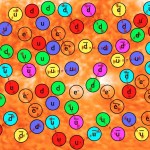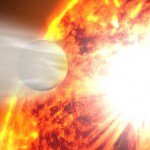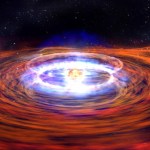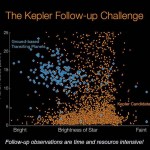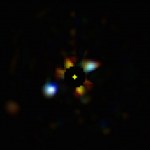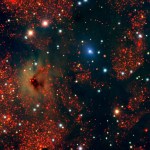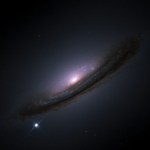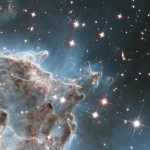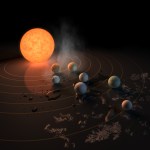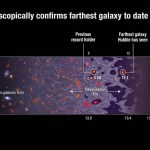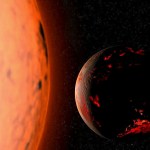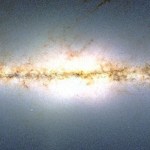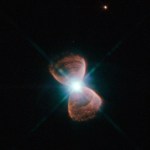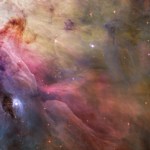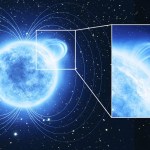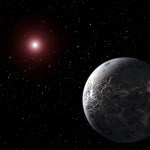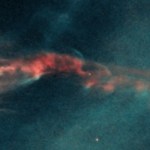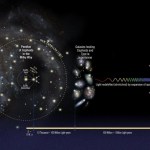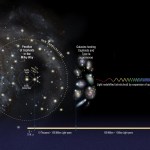Stars
“It is the function of science to discover the existence of a general reign of order in nature and to find the causes governing this order. And this refers in equal measure to the relations of man - social and political - and to the entire universe as a whole.” -Dmitri Mendeleev
When the Big Bang first occurred, the Universe was filled with all the various particles and antiparticles making up the Standard Model, and perhaps still others yet to be discovered. But missing from the list were protons, neutrons, or any of the atomic nuclei key to the life-giving elements in our Universe today.…
"As far as I can tell, every telescope that can look at it right now is looking at it right now." -Matt Muterspaugh
Earlier this decade, the Kepler mission became the most successful planet-finding endeavor of all time, turning up thousands of new worlds by measuring the transit data of some 150,000 stars. When planets passed in front of their parent star, they blocked a tiny fraction of their light, leaving behind an imprint of a periodic dimming signal. But one star dims differently from all the others.
Different steps in the Kepler time series data that show the periodic and aperiodic…
"End? No, the journey doesn't end here. Death is just another path, one that we all must take. The grey rain-curtain of this world rolls back, and all turns to silver glass, and then you see it." -J.R.R. Tolkien
Stars live for a variety of ages, from just a million or two years for some to tens of trillions of years for others. But even after a star has run out of its fuel and died, its stellar corpse continues to shine on. Neutron stars and white dwarfs are both extremely massive, but very small in volume compared to a star. As a result, they cool very slowly, so slow that a single one has…
"A few centuries ago, the pioneer navigators learnt the size and shape of our Earth, and the layout of the continents. We are now just learning the dimensions and ingredients of our entire cosmos, and can at last make some sense of our cosmic habitat." -Martin Rees
You might think that Jupiter is the largest planet in the Solar System because it’s the most massive, but that’s not quite right. If you kept adding mass to Saturn, it would get larger in size, but if you kept adding mass to Jupiter, it would shrink! For a given set of elements that your planet is made out of, there’s a maximum…
"Resources exist to be consumed. And consumed they will be, if not by this generation then by some future. By what right does this forgotten future seek to deny us our birthright?" -Sid Meier's Alpha Centauri
The dream of humanity has long been to identify an inhabited world beyond Earth, to know for certain that life is not unique to our pale blue dot. If we were located a great distance away, there are observations of Earth we could make that would tell us a tremendous amount of information about our world, including about its oceans, clouds, continents, the "greening" of our…
"Things need not have happened to be true. Tales and adventures are the shadow truths that will endure when mere facts are dust and ashes and forgotten." -Neil Gaiman
Wherever we look in the night sky, we don't just observe the background sources of light shining our way, but also the effects of all the matter in between those distant sources and our eyes. Since all of that inbound light needs to pass through a portion of the Milky Way on its way to our eyes, it's vital that we understand how that light is distorted by our own galaxy. That means we need an understanding of the dust in our own…
“Without these supernova explosions, there are no mist-covered swamps, computer chips, trilobites, Mozart or the tears of a little girl. Without exploding stars, perhaps there could be a heaven, but there is certainly no Earth.” -Clifford A. Pickover
One of the most sobering cosmic truths is that every star in the Universe will someday run out of fuel and die. Once its core fuel is exhausted, all it can do is contract under its own gravitational pull, fusing heavier and heavier elements until it can go no further. Only the most massive stars, capable of continuing to fuse carbon (and even…
"With the Hubble telescope and all the other things that are out there, I believe something would have come through. Today, I really believe we are unique." -Mark Goddard
Want to identify where stars are forming (or about to form) in the Universe? We’ve got no problem using visible light, which reveals unambiguous signatures associated with newborn stars. But if you want to view those stars themselves, or the processes occurring within the nebula where they’re being born? You have to go to infrared light.
Taken in infrared light, the image shows the dense column and the surrounding greenish-…
"It isn't only the beauty of the night sky that thrills me. It's the sense I have that some of those points of light are the home stars of beings not so different from us, daily cares and all. who look across space with wonder, just as we do." -Frank Drake
What is it that makes our Solar System special? It’s Earth, of course. A rocky planet of the right mass and composition, the right distance from our Sun, the right atmosphere, the surface oceans, and all the life that’s ensued is what makes us special. Not just special, but unique, at least among the planets we’ve found so far.
The orbits…
"For the first time we can learn about individual stars from near the beginning of time. There are surely many more out there." -Neil Gehrels
We’ve come incredibly far in our quest to learn how the Universe came to be the way it is today. We can see out in space for tens of billions of light years, to galaxies as they were when the Universe was only a few percent of its present age. We can see how galaxies evolve, merge and the stars inside change. And we can see to even before that, when no stars or galaxies existed at all.
The farthest galaxy known to date, which was confirmed by Hubble,…
"The way to love anything is to realize that it might be lost." -G. K. Chesterton
Worried about the environment of Earth today? Here’s a sobering fact: we already know how it’s all going to end. Not just when the next ice age will come or the next supervolcano will blow, but on cosmic scales stretching billions of years into the future and beyond. From the death of life on Earth to the end of the Sun, we can predict some major catastrophes our Solar System will face.
The Earth, if calculations are correct, should not be engulfed by the Sun when it swells into a red giant. It should, however…
"Far out in the uncharted backwaters of the unfashionable end of the western spiral arm of the Galaxy lies a small unregarded yellow sun. Orbiting this at a distance of roughly ninety-two million miles is an utterly insignificant little blue green planet whose ape-descended life forms are so amazingly primitive that they still think digital watches are a pretty neat idea." -Douglas Adams
If you want to know how many and what type of chemical elements are present in a star system, you need to make a dizzying, intricate array of observations. You need to break up the light from the star into…
"A bit of mould is a pleiad of flowers; a nebula is an ant-hill of stars." -Victor Hugo
In the distant future, about 7 billion years from now, our Sun will run out of all the nuclear fuel it’s capable of burning in its core. As it contracts under its own gravity, radiation becomes unable to hold it up any longer. Gravitation takes over, and the outer layers get blown off as the core contracts down into a white dwarf.
A star reaching the end of its life goes from fusing nuclei to blowing off its outer layers and contracting down. Image credit: NASA, ESA, and A. Zijlstra (The University of…
"We are not the same persons this year as last; nor are those we love. It is a happy chance if we, changing, continue to love a changed person." -W. Somerset Maugham
After 13.8 billion years have gone by, you might not think that a year makes much of a difference. A year to the Universe is like 0.2 seconds -- the literal blink of an eye -- to a human being. Yet even though changes might be gradual, they’re real, and they very much add up over time.
A region of the Orion Nebula, one of the largest and most rapidly-star-forming regions where star birth takes place. Image credit: NASA, ESA and…
"Science doesn't always go forwards. It's a bit like doing a Rubik's cube. You sometimes have to make more of a mess with a Rubik's cube before you can get it to go right." -Jocelyn Bell-Burnell
Observations that surprise us, of a phenomenon we weren’t expecting and don’t have an explanation for, are some of the most exciting things we can encounter in astronomy. In 1967, regularly pulsing radio sources, discovered without any expectation, provided exactly that. It wasn’t noise; it was definitely a robust, repeatable observation; so what was it?
The data from the first pulsar ever found…
"This isn't my life anymore, Mulder. I'm done chasing monsters in the dark." -Dana Scully, X-files
One of the most exciting things a scientist can experience is when they look at a sample of data, expecting to not see a particular exciting effect, and yet, something’s there. Immediately, you have to check yourself: what are all the other things it could be? What are the mundane possibilities that could mimic that effect? And what can I do, if anything, to rule them out? Whenever you have a new idea, your main job, first and foremost, is to try and blow the biggest holes in it you possibly can…
“From our home on the Earth, we look out into the distances ... to imagine the sort of world into which we are born… . But with increasing distance our knowledge fades, and fades rapidly, until at the last dim horizon we search among ghostly errors of observations for landmarks that are scarcely more substantial. The search will continue. The urge is older than history. It is not satisfied and it will not be suppressed.” -Edwin Hubble
Once thought to include anything that wasn’t a star, moon or planet in the night sky, our understanding of nebulae has grown tremendously over the…
“Scratch a cynic and you'll find a disappointed idealist.” -Jon F. Merz
The stars overhead might twinkle and cause us to wonder what they are, exactly, but perhaps a more important question is to wonder where they are. If we can determine the distances to the stars, and then use those known distances to measure the distances to other galaxies, we can not only determine how far away they are, but determine how the Universe has expanded over the course of its cosmic history.
The construction of the cosmic distance ladder involves going from our Solar System to the stars to nearby galaxies to…
"Teaching man his relatively small sphere in the creation, it also encourages him by its lessons of the unity of Nature and shows him that his power of comprehension allies him with the great intelligence over-reaching all." -Annie Jump Cannon
A look up at the stars in the night sky shows a clear distinction: some are fainter while others are brighter, some are redder while others are bluer, some are closer while others are much farther away. But what accounts for the differences -- some real and some only apparent -- between these stars? For most of human history, not only didn’t we know,…
“We can only see a short distance ahead, but we can see plenty there that needs to be done.” -Alan Turing
The Cosmic Microwave Background data gave us an unprecedented picture of our Universe in terms of accuracy, with the latest Planck results showing us our Universe is 68% dark energy, 13.8 billion years old and is expanding at a rate of 67 km/s/Mpc. Too bad, then, that the Cosmic Microwave Background isn't the only way to measure the expansion rate, and that direct measurements -- using the cosmic distance ladder -- disagree with that significantly.
A map of star density in the Milky Way…
